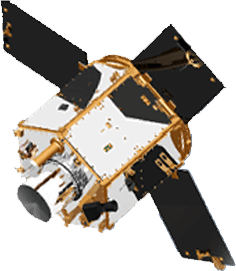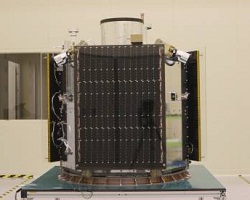|
RazakSAT
RazakSAT is a Malaysian Earth observation satellite carrying a high-resolution camera. It was launched into low Earth orbit on 14 July 2009. It was placed into a near-equatorial orbit that presents many imaging opportunities for the equatorial region. It weighs over three times as much as TiungSAT-1 and carries a high resolution Earth observation camera. Developed in conjunction with Satrec Initiative, the satellite's low inclination orbit (9 degrees) brought it over Malaysia a dozen or more times per day. This was intended to provide greatly increased coverage of Malaysia, compared to most other Earth observation satellites. An audit report released in October 2011 revealed that the satellite had failed after only 1 year of operation. RazakSAT was the first and only operational satellite to be put in orbit by SpaceX's Falcon 1. Background This satellite is Malaysia's second remote sensing satellite after TiungSAT-1. Originally called MACSAT, RazakSAT's payload is mainly elect ... [...More Info...] [...Related Items...] OR: [Wikipedia] [Google] [Baidu] |
Falcon 1
Falcon 1 was a small-lift launch vehicle that was operated from 2006 to 2009 by SpaceX, an American aerospace manufacturer. On 28 September 2008, Falcon 1 became the first privately-developed fully liquid-fueled launch vehicle to go into orbit around the Earth. The two-stage-to-orbit rocket used LOX/RP-1 for both stages, the first powered by a single Merlin engine and the second powered by a single Kestrel engine. It was designed by SpaceX from the ground up. The vehicle was launched a total of five times. After three failed launch attempts, Falcon 1 achieved orbit on its fourth attempt in September 2008 with a mass simulator as a payload. On 14 July 2009, Falcon 1 made its second and final flight, successfully delivering the Malaysian RazakSAT satellite to orbit on SpaceX's first commercial launch (fifth launch overall). Following this flight, the Falcon 1 was retired and succeeded by Falcon 9. SpaceX had announced an enhanced variant, the Falcon 1e, but development was st ... [...More Info...] [...Related Items...] OR: [Wikipedia] [Google] [Baidu] |
Astronautic Technology (M) Sdn
Astronautic Technology Sdn Bhd or better known as ATSB was established on 1 May 1995 and is wholly owned by the Minister of Finance Inc under the supervision of the Malaysian Ministry of Energy, Science, Technology, Environment and Climate Change (MESTECC). As a wholly owned company under the Ministry of Finance Inc., ATSB is mandated to focus on research and development in the area of design and development of space-qualified systems employing advanced and innovative technologies. Space projects ATSB was entrusted with the design, development, launch and operation of TiungSAT-1, Malaysia's first microsatellite that was launched aboard a Dnepr rocket from Baikonur Cosmodrome, Kazakhstan on 26 September 2000. The technical expertise and experience gained in handling TiungSAT-1 served as a stepping stone for the second microsatellite, RazakSAT, which was successfully launched on 14 July 2009. RazakSat failed after a year, and never became fully operational. ATSB developed the c ... [...More Info...] [...Related Items...] OR: [Wikipedia] [Google] [Baidu] |
Astronautic Technology Sdn Bhd
Astronautic Technology Sdn Bhd or better known as ATSB was established on 1 May 1995 and is wholly owned by the Minister of Finance Inc under the supervision of the Malaysian Ministry of Energy, Science, Technology, Environment and Climate Change (MESTECC). As a wholly owned company under the Ministry of Finance Inc., ATSB is mandated to focus on research and development in the area of design and development of space-qualified systems employing advanced and innovative technologies. Space projects ATSB was entrusted with the design, development, launch and operation of TiungSAT-1, Malaysia's first microsatellite that was launched aboard a Dnepr rocket from Baikonur Cosmodrome, Kazakhstan on 26 September 2000. The technical expertise and experience gained in handling TiungSAT-1 served as a stepping stone for the second microsatellite, RazakSAT, which was successfully launched on 14 July 2009. RazakSat failed after a year, and never became fully operational. ATSB developed the c ... [...More Info...] [...Related Items...] OR: [Wikipedia] [Google] [Baidu] |
Satrec Initiative
Satrec Initiative Co., Ltd. (Korean: 쎄트렉아이) or Satrec i or SI is a South Korean satellite manufacturing company headquartered in Daejeon, South Korea The company was founded in 1999 by the engineers who developed the first Korean satellite (KITSAT-1) at KAIST Satellite Technology Research Center (SaTRec). The company designs and builds Earth observation satellites called SpaceEye-series, and it provides various space components, including high resolution electro-optical payloads and star-trackers. SI's first satellite was a Malaysian Earth observation satellite, RazakSAT launched in 2009. SI has two subsidiaries: SI Imaging Services (SIIS) is the exclusive image data provider of KOMPSAT-series, and SI Analytics (SIA) provides AI-native GEOINT solutions for satellite imagery. SI also spun-off SI Detection (SID), which provides radiation monitoring solutions. History Satrec Initiative was founded in Daejeon, South Korea in 1999. There are two subsidiaries established b ... [...More Info...] [...Related Items...] OR: [Wikipedia] [Google] [Baidu] |
SpaceX Commercial Payloads
Space Exploration Technologies Corp. (SpaceX) is an American Aerospace manufacturer, spacecraft manufacturer, space launch, launcher, and a Telecommunication, satellite communications corporation headquartered in Hawthorne, California. It was founded in 2002 by Elon Musk with the stated goal of reducing space transportation costs to enable the colonization of Mars. The company manufactures the Falcon 9, Falcon Heavy, and SpaceX Starship, Starship launch vehicles, SpaceX rocket engines, several rocket engines, SpaceX Dragon 2, Cargo Dragon and Crew Dragon spacecraft, and Starlink communications satellites. SpaceX is developing a satellite internet constellation named Starlink to provide commercial internet service. In January 2020, the Starlink constellation became the largest satellite constellation ever launched, and as of December 2022 comprises over 3,300 small satellites in orbit. The company is also developing Starship, a privately funded, Fully-reusable orbital launch v ... [...More Info...] [...Related Items...] OR: [Wikipedia] [Google] [Baidu] |
SpaceX
Space Exploration Technologies Corp. (SpaceX) is an American spacecraft manufacturer, launcher, and a satellite communications corporation headquartered in Hawthorne, California. It was founded in 2002 by Elon Musk with the stated goal of reducing space transportation costs to enable the colonization of Mars. The company manufactures the Falcon 9, Falcon Heavy, and Starship launch vehicles, several rocket engines, Cargo Dragon and Crew Dragon spacecraft, and Starlink communications satellites. SpaceX is developing a satellite internet constellation named Starlink to provide commercial internet service. In January 2020, the Starlink constellation became the largest satellite constellation ever launched, and as of December 2022 comprises over 3,300 small satellites in orbit. The company is also developing Starship, a privately funded, fully reusable, super heavy-lift launch system for interplanetary and orbital spaceflight. It is intended to become SpaceX's primary orbi ... [...More Info...] [...Related Items...] OR: [Wikipedia] [Google] [Baidu] |
Omelek Island
Omelek Island (; Marshallese: , pronounced ) is part of the Kwajalein Atoll in the Republic of the Marshall Islands. It is controlled by the United States military under a long-term lease (along with ten other islands in the atoll) and is part of the Ronald Reagan Ballistic Missile Defense Test Site. Geography The Island is about in size. Geologically, it is composed of reef-rock, as are the other islands in the atoll, which is created by the accumulation of marine organism remnants (corals, Mollusca, etc.) Rocket launches Omelek has long been used by the United States for small research launch vehicle launches due to its relative isolation in the South Pacific. The last U.S. government rocket launch occurred in 1996. After 2000, the island's equatorial proximity and nearby radar tracking infrastructure attracted SpaceX, an orbital launch provider, which updated facilities on the island and established it as their primary launch location by 2006. SpaceX began launchi ... [...More Info...] [...Related Items...] OR: [Wikipedia] [Google] [Baidu] |
SI-200
The SI-200 satellite bus was a model of satellite, based on the Malaysian RazakSAT, produced by the South Korean Satrec Initiative. The bus was suitable for small satellites where the accommodation of Earth observation or other scientific payloads is required, and was used on the Emirati remote sensing satellite DubaiSat-1 DubaiSat-1 ( ar, دبي سات-1) is a remote sensing Earth observation satellite built by the '' Emirates Institution for Advanced Science and Technology (EIAST)'' under an agreement with Satrec Initiative, a satellite manufacturing company in ... launched in 2009. Features * Three-axis stabilized, accurate and agile attitude control for precise imaging operations. * Dual redundancies are adapted where necessary in the system architecture design to increase reliability of the satellite system. * Dimensions: 1.2 m in diameter and 1.35 m in height. * Deck-and-longeron type structure permitting easy assembly and disassembly. The interface with the la ... [...More Info...] [...Related Items...] OR: [Wikipedia] [Google] [Baidu] |
Low Earth Orbit
A low Earth orbit (LEO) is an orbit around Earth with a period of 128 minutes or less (making at least 11.25 orbits per day) and an eccentricity less than 0.25. Most of the artificial objects in outer space are in LEO, with an altitude never more than about one-third of the radius of Earth. The term ''LEO region'' is also used for the area of space below an altitude of (about one-third of Earth's radius). Objects in orbits that pass through this zone, even if they have an apogee further out or are sub-orbital, are carefully tracked since they present a collision risk to the many LEO satellites. All crewed space stations to date have been within LEO. From 1968 to 1972, the Apollo program's lunar missions sent humans beyond LEO. Since the end of the Apollo program, no human spaceflights have been beyond LEO. Defining characteristics A wide variety of sources define LEO in terms of altitude. The altitude of an object in an elliptic orbit can vary significantly along the orbit. ... [...More Info...] [...Related Items...] OR: [Wikipedia] [Google] [Baidu] |
Spacecraft Launched In 2009
A spacecraft is a vehicle or machine designed to fly in outer space. A type of artificial satellite, spacecraft are used for a variety of purposes, including communications, Earth observation, meteorology, navigation, space colonization, Planetary science, planetary exploration, and Space transport, transportation of Human spaceflight, humans and cargo spacecraft, cargo. All spacecraft except single-stage-to-orbit vehicles cannot get into space on their own, and require a launch vehicle (carrier rocket). On a sub-orbital spaceflight, a space vehicle enters outer space, space and then returns to the surface without having gained sufficient energy or velocity to make a full Earth orbit. For orbital spaceflights, spacecraft enter closed orbits around the Earth or around other Astronomical object, celestial bodies. Spacecraft used for human spaceflight carry people on board as crew or passengers from start or on orbit (space stations) only, whereas those used for robotic space m ... [...More Info...] [...Related Items...] OR: [Wikipedia] [Google] [Baidu] |
Earth Imaging Satellites
Earth is the third planet from the Sun and the only astronomical object known to harbor life. While large volumes of water can be found throughout the Solar System, only Earth sustains liquid surface water. About 71% of Earth's surface is made up of the ocean, dwarfing Earth's polar ice, lakes, and rivers. The remaining 29% of Earth's surface is land, consisting of continents and islands. Earth's surface layer is formed of several slowly moving tectonic plates, which interact to produce mountain ranges, volcanoes, and earthquakes. Earth's liquid outer core generates the magnetic field that shapes the magnetosphere of the Earth, deflecting destructive solar winds. The atmosphere of the Earth consists mostly of nitrogen and oxygen. Greenhouse gases in the atmosphere like carbon dioxide (CO2) trap a part of the energy from the Sun close to the surface. Water vapor is widely present in the atmosphere and forms clouds that cover most of the planet. More solar energy is re ... [...More Info...] [...Related Items...] OR: [Wikipedia] [Google] [Baidu] |


.jpg)

